Ray Clark has interviewed numerous people involved with Radio Caroline for his documentaries and his book, Radio Caroline: The True Story Of The Boat That Rocked (reviewed here).
One of the interviewees was sixties Caroline engineer Carl Thomson.
Carl mainly worked on the mv Mi Amigo, Radio Caroline South, but - as you can read below - also spent time on the north ship.
He joined the station in September 1965, aged 23. At that time the two ships were broadcasting under the same Radio Caroline name but in fact they had different management teams. Caroline South was still owned by Project Atlanta. A
few months later the operators of Caroline North took control of them both.
We are grateful to Ray for sharing this fascinating interview which took place on 3rd December 2012.
|
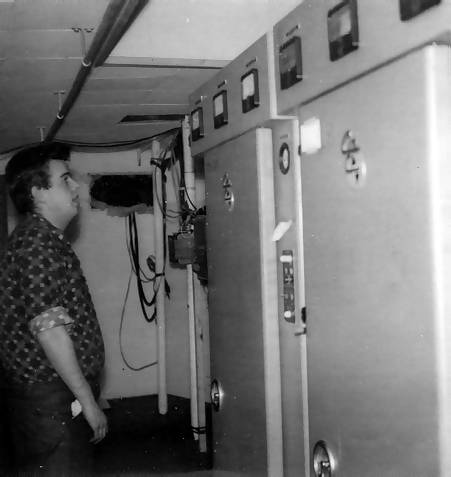
|
|
Carl Thomson checks the Caroline North transmitters. Photo provided by Carl. For more of his pictures, see here.
|
CARL THOMSON: When I started I was employed by Radio Atlanta and my money was paid by a company called Hengown Ltd.. I think the merger took place after the grounding because then my money was paid by Planet
Productions. I think that's when Caroline took over fully the Mi Amigo side of things. Before that, although they were transmitting as Radio Caroline South, I think that was more an office thing than a complete takeover.
Initially, how I got involved was... A guy came to see me in Marconi Marine. He worked in Marconi Marine and he said would I like to do some work on transmitters elsewhere. I then went for an interview down at Billericay, with a guy
who went to New Zealand. The next thing I knew I had a letter from a guy by the name of Mr. Gilman who did an interview down at Harcourt Shipping in Harwich. He wanted me to start the next week but, of
course, working for Marconi Marine I had to give three months' notice so I didn't start until September time 1965. That was the first time we went out to the Mi Amigo.
RAY CLARK: When they came to you and asked if you were interested, had you expressed an interest?
CT: No. They wanted someone who knew about radio transmitters and that was my speciality at the time. So that's why I went. I got recommended and went for the interview. Out there there was already George
Saunders, who also came from Marconi Marine. He was a technical writer and George had been with them from the start. We went out to the Mi Amigo. At that time we were running 10 kilowatts and trying to get the 20 kilowatt working.
From then on we did two (weeks) on and two off until we came up on the beach one day[1]. After that the Mi Amigo went to Holland where it was refitted with a 50 kilowatt (transmitter) and I think the money
required for the new Continental Electronics (transmitter) came from Caroline rather than the Hengown (Atlanta) side of things because then the Caroline people took over completely and a lot of the faces concerned with Radio Atlanta
disappeared.
|

|
|
Letter heading for Hengown Ltd., the company that paid the south ship DJs and engineers. Kindly provided by Colin Nicol.
|
After the grounding I was travelling backwards and forwards to Holland for the Mi Amigo. We then started on the Cheeta II[2]. Ronan had got that from the Swedes. That came across with a crew. We had a
bit of trouble on the Cheeta II. We had to go to Lowestoft because one of the pumps failed and water was coming in. We had to go off the air. We spent a few weeks up in Lowestoft then we came back. Then we went back on the Mi Amigo
and we started the 24 hour a day broadcasts which carried on until I left in April '67. So I was on the ship for 18 months or more, working out there.
|
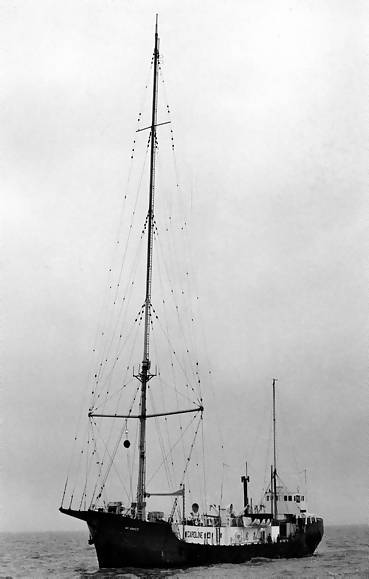
|
|
The mv Mi Amigo. Photo kindly provided by Carl.
|
RC: Did you ever find out who it was that recommended you to Caroline?
CT: Well I know the name of the guy who came to see me but never found out anything else, you know. Your name gets bandied around and such like. That's how things happen.
RC: You were saying you were employed by a different company. Presumably there were a number of different company names?
CT: Yes. There was. Hengown Ltd. was the one that I knew. All the people from Radio Atlanta were paid by those people. They had an address at 47 Dean Street. Gilman was the engineer that interviewed me and Gomeche was the financial
man. I started on 24th September 1965 on a salary of £25 per week.
RC: Was that good money for engineers at that time?
CT: I was on a fiver a week at Marconi so... (laughs)
RC: You were paid on board?
CT: No. They sent a cheque to you once a month, or a bank transfer.
RC: They were OK payers?
CT: Oh yes. The money kept on coming. There was never a problem with finance on the offshore side of things. We were paid. That went into the bank but we were self-employed so you had to get an accountant to sort your tax out. I think
I paid him 7 guineas (£7.35) the first year. He sorted the tax out. Coming from PAYE to self-employed taxes was an eye-opener.
RC: You did stuff on the north ship as well, didn't you?
CT: Yes. After the grounding a lot of people left so then I became the sort of senior engineer, the one who had been there the longest. That meant I ran the offshore side. I was responsible for going up to the north ship occasionally
to do checks up there and such like. When Manfred (Sommer) was off. He was the engineer up there. He was an Austrian. He stayed on the north ship about 3 or 4 months at a time but, if he came off for a
bit, I used to go up there and do a bit on the north ship as well. So I covered both ships - for a period of time anyway, towards the end.
The other thing I got involved with was, when we were still under Project Atlanta - so that must have been between September '65 and January '66 - I got involved with going out on Radio City. Radio City had bought a transmitter from
the States which was a large 10kW device[3]. It has been taken apart in the States and all the cabling had got labels on. We were told, Ted Walters and myself - Ted was the
chief engineer at that time - we were told it would be a doddle because ‘everything's marked’. Well, when we got to Radio City we found that one of the cabinets had been dropped in the Thames - the sling had broken - and
all the paper markings had come off. So we never really did get that running - plus the fact that it was soaked with sea water. That was involved with Smedley (Project Atlanta's chairman) and the rest of them. Something happened there
that led to altercations between whoever. There was a bit of monkey-business going on there.
RC: Wasn't there going to be a tie-up between Caroline and City?
CT: There was but I think that finished it. I remember we went out to City and, compared to the Mi Amigo, it was very basic. (laughs)
RC: I am guessing they would have replaced the Mi Amigo with the fort and sent the Mi Amigo somewhere else. Was that spoken about?
CT: No. There was all sorts of rumours but they were just rumours, you know. I don't really know.
RC: Was the lay-out very different between the north and south ships? The north ship was much bigger, wasn't it, but was it done differently?
CT: Yes. It was done completely differently. The Mi Amigo had (previously) been Radio Nord over in Sweden. The original ship had been taken over and, at some stage, this ex-sailing vessel had been lengthened with some steel plates in
the centre and some water tanks had been dropped in there which lengthened the ship, which was done for the Swedes. They also designated the transmitter hall in there, in the hold. They put accommodation into the hold of this ship so
your accommodation was basically where the hold was. So it was purpose-built. Now the Fredericia was an ex-Danish ferry which had the passenger accommodation for the DJs. They could use that and some of the crew accommodation was there
too. The main lounge, the passengers' dining area, was the communal area and towards the stern of the vessel they used a room - I don't know what its previous use was - the transmitters were mounted in there. The studios were built on
the deck above which had an open view over the sea. So the lay-out was completely different. They also had a long feeder run to the aerials which went through the various lounges ...
RC: Between the transmitters at the stern and the mast at the front ...
CT: Yeah. The layout was completely different. It didn't matter one way or the other really. You just had to take it into account. With the Mi Amigo everything was much more compact. It was smaller. I always found it a lot more cosy,
if you like. On the Mi Amigo you were living on top of one another but on the Fredericia you at least could get away to a quiet spot.
RC: What about London? From what I read the guys off the Isle of Man ... it didn't matter what London said because they couldn't hear them. They were their own bosses, sort of thing.
CT: Yeah. I heard that the money was made in London with the advertising. The north ship carried the advertising and had a bigger audience because it had Liverpool and Manchester, the Isle of Man, and northern Ireland - all from the
north ship, so the audience up north was far bigger but the Mi Amigo was generating the cash to keep them both running. But how true that was, I don't know, because our audience (down south) was cut in half by the others that were
around like Big L and such like. But the audience of Caroline South was still 30 million[4] so Lord knows what Big L's was.
RC: The north ship. Was that run by Planet Productions?
CT: It was all Planet Productions. It was all serviced by the same tender company, Red Wings[5], which was an offshoot of Wijsmuller I think, over in Holland. I think they were registered in Liechtenstein or one of those countries.
RC: That was Red Wings - a branch of Wijsmuller?
CT: Yes. I think it was called Red Wings. The actual people that ran the tenders and such like.
RC: What were your daily tasks? What did an engineer on the ships have to do?
|
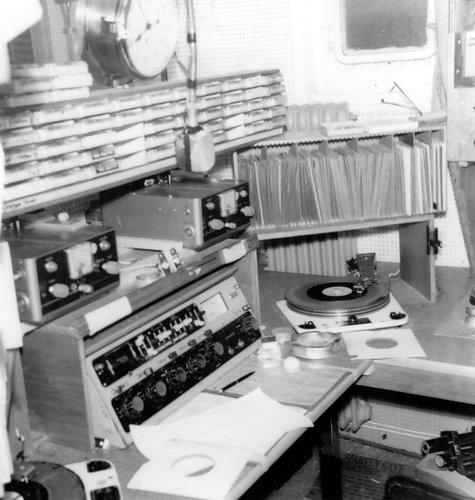
|
|
The Caroline South studio. This became the news studio later when a new DJ studio was built. Photo provided by Carl.
|
CT: Basically during the day your main tasks were just to keep the readings - we used to take readings every hour or so of what the various parameters of the transmitter were doing, check on the compression levels -
we used to alter those depending on which DJ was on, just slightly, so that we could keep the average modulation at the right level. Maybe you'd need a bit more compression for Rosko and a little less
for Rick Dane or one of the others who came in because they didn't shout into the microphone so much. You had to just see if any faults developed, and you had to fix them basically. And during the night,
after 12 o'clock, then you had to work and clean the studio, clean all the (tape) heads and, in the transmitter, make sure you washed all the filters to get rid of the salt out of them and suchlike.
RC: So you were kept busy then. Did you keep many spares on board?
CT: There was a good quantity of spares. Only once did we have to go to the States to get extra spares. On the 50 kilowatt transmitter, the biggest problem we had was... You have to appreciate these transmitters were designed to work on
land but we had them at sea. You had air going through to keep the main amplifier valves cool but, the way they were designed, on the valve base was a thin neoprene washer that went round and insulated one thing from another. Well,
with salt air going through, it deposited salt on this ring. That tracked across and blew. So we were forever replacing these rings and, of course, they had to come across from the States. And that's when it got a bit difficult. If
we ran out of those we immediately had to re-order to make sure we had enough of them coming across. That's the only time that the spares situation was a little bit of a problem.
RC: What about the mast? Was that your domain or did you get riggers out if anything went adrift on the mast? Did you have to go up?
CT: No. That was the riggers. The only problem we had was, when we went to 50 kilowatts, we started to burn the insulators and the wires through. And then we had riggers out from ... I think they came from a firm called Coubro and
Scrutton (?) out of Tilbury Docks and they came out with the new wires and the new insulators. They came out and re-rigged the mast. And that's the only time I saw people go up that mast in welly boots and sou'westers in a gale to
replace them. So we had to come off air for a little bit while they were doing that.
RC: Were you on board when Tony Blackburn went up[6]?
CT: I was on the Cheeta when he went over to try and clear this wire aerial that someone decided they would put up in place of what was there - which was, in my opinion, an idiotic thing to do. But (station boss)
Ronan (O'Rahilly) offered £50 to whoever would go up and everyone took one look at it and thought ‘no’ but Tony thought he'd try and earn £50. I think he did clear a bit of it.
RC: Was it a bit of rogue wire?
CT: No. They tried to put a different type of aerial up. They changed the aerial system. Someone in Caroline had decided to do away with the aerial system that the Mi Amigo had originally and they would rearrange the aerial system to
this new one for the 50 kilowatt. And they also wanted to put this extra wire up, and of course the wire snapped and fouled the coils and everything else. So they were in big trouble then. Tony went across with a few of the DJs. I
was on the Cheeta but we saw what he was trying to do. I think he did clear it. Then we went over and went on board to get the transmitter running. I think one of the transformers burnt out on there as well. We were trying to tune it
and suddenly the lights dimmed. I ran down and there was smoke in the transmitter room. One of the main transformers had gone. Continental Electronics replaced that free of charge. I think it was a design fault.
RC: So this was the 50 kilowatt, the new transmitter. You went over (to Holland) didn't you, after the grounding?
|
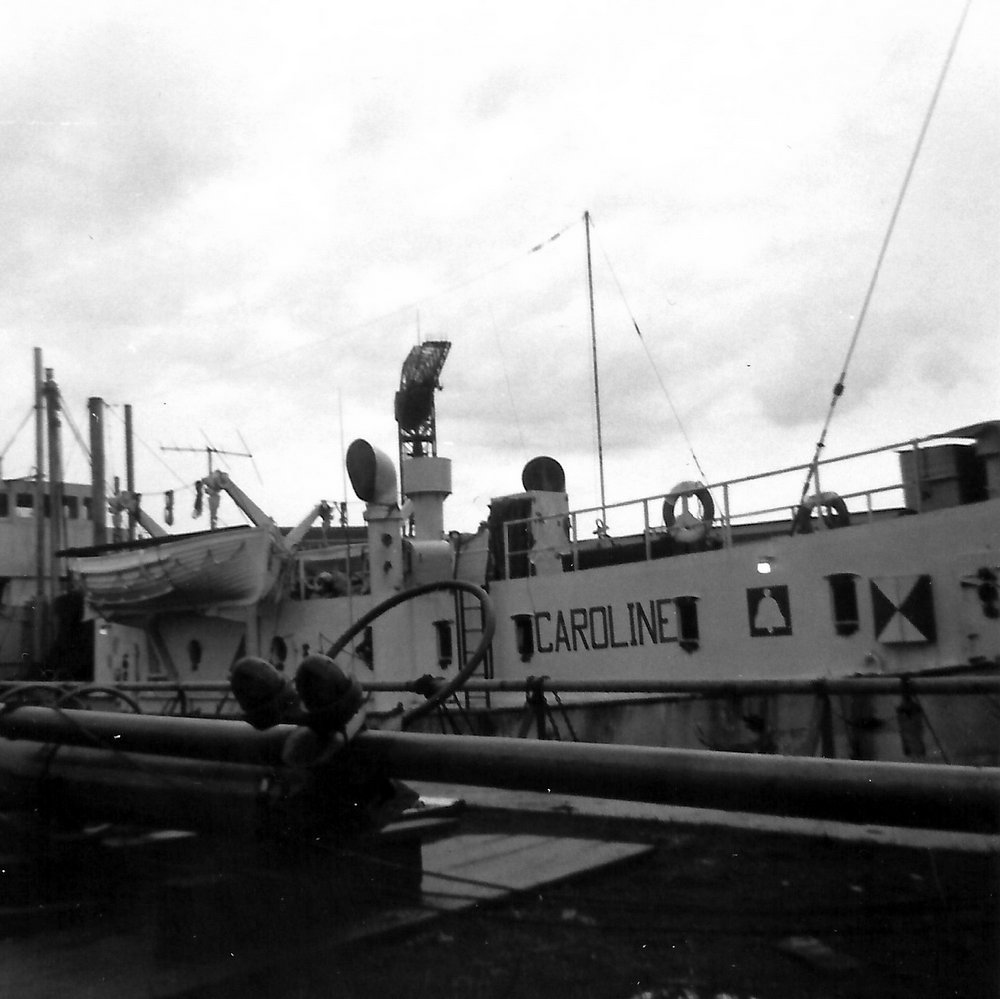
|
|
The mv Mi Amigo in Zaandam harbour. Photo by Rob Olthof. More of his pictures can be found here.
|
CT: After the grounding we spent some time in the hotels around Dovercourt. The first night we spent, I think, in a hotel in Walton-on-the-Naze and then we moved to a hotel in Dovercourt. (On-shore liaison man)
Bill Scadden arranged all of this. We hung around and hung around and then they got the Mi Amigo off (the beach) and they said they wanted someone to go across with the transmitter. I think George (Saunders) already had a new job
so I said I'd go. And then Patrick Starling said he'd come with me because we didn't know what would happen on the way over. We went out on Offshore I, went on board (the Mi Amigo) and then, with
the Titan II pulling us, we left to go to Holland. We started off at a tremendous rate of knots and then the next morning... I'd gone to bed about 11 o'clock. The next morning got up, walked down to see whether I could tidy up
anything in the transmitter room before we got to Holland. I noticed it was thick fog and we were only just moving along. When I got to the transmitter room it looked like a bomb had hit it. There were pumps and Lord knows what
else and these water tanks they'd put in with the steel section underneath the water tanks had sprung, and there was water coming in like a good'un. All the pumps were running to try to keep her afloat. I just got everything and
put everything up high in the transmitter room, thinking we might be able to hold it (laughs). Late evening that day we approached Ijmuiden and, as we came in to Ijmuiden - I'll remember it to my dying day - there's a hill in
Ijmuiden with the lighthouse on it. As we came in, it just looked like ants. The whole of that hill was covered with people getting a view (of the ship). And as we went into the locks there were hundreds of people around to look at
us come in. We then went into the North Sea Canal and they towed us all the way up to a shipyard in Zaandam. We spent some time there.
RC: She was dry-docked there, was she?
CT: She was dry-docked.
RC: And did you see what damage had been done?
CT: Oh yeah. Mainly rivets knocked out. When they inspected the vessel... It was because they had an iron and steel thing. There was corrosion there. A lot of areas had gone thin so they patched it up the best they could to make it
seaworthy again. They lifted the transmitters out[7] and, before she sailed from Ijmuiden, they put the transmitters back in but, by the time she was ready to sail, I was over on the Cheeta II, running the Cheeta II.
RC: So was the original plan to get the new transmitter and then the fact she went aground that was just coincidence? Otherwise you'd have had to have done it at sea I suppose ...
CT: Yeah. They'd have to strip one out and put the other one whilst at sea. We'd got the 20 kilowatts running (the two 10 kilowatt transmitters combined) by then but what happened was, when it went aground, the transmitters were
stripped out in Zaandam. One 10 kilowatt and the combiner went to the north ship. We had to go and get the combiner running on the north ship. The north ship went up to 20 kilowatts and the south ship had one 10 kilowatt and this new
50 kilowatt. We had the 50 across in the hold and the 10 kilowatt at the bottom of the stairs. If we went on the 10 kilowatt you could hardly hear it (the station) so we kept the 50 going all the time.
RC: I can remember as a kid trying desperately to tune in when Caroline was off and there was nothing there. You had a lot of trouble with the Cheeta, getting that to do anything, didn't you?
|
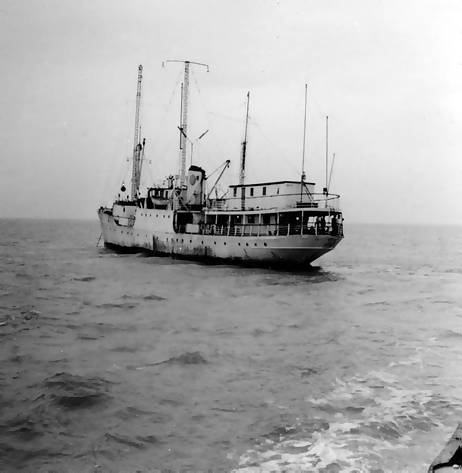
|
|
The mv Cheeta II. Photo provided by Carl.
|
CT: Oh yeah. The Cheeta was a stop-gap shall we say. We couldn't get a big aerial on it because in Sweden the Cheeta was more of an FM station. FM was big. Before we had it over here, on the Continent FM was big, you
know, for local radio. So that was more of an FM station and, of course, to get a mast up which could carry an antenna that allowed us to broadcast, it was difficult. I think we put out about 6 kilowatts. That was the maximum we could
put out on the Cheeta II. And of course the crew were messing around with something down in the engine room and they opened a sea-valve, and they couldn't shut it, so water was pouring in. A tug had to come out from Harwich and tow
us to Lowestoft. We had to go into Lowestoft.
RC: When things were running normally and you were on the ship, was there a link to land? Were you able to use a dodgy link or did you have to wait for the tender to come out?
CT: The tender used to come out. Of an evening I used to go and have a little chat with a guy on shore on a link, just to tell him everything was OK and whether there were any messages we had to pass on. And there were certain records,
as you know, that they played if there was any trouble or messages to Caroline House that the DJ would put over, and hope that someone in Caroline House in Chesterfield Gardens was listening to it. Whether they were or they weren't,
you didn't know.
RC: How many tenders a week did you have?
CT: When I was out there, there was one a day except Sundays. Mainly the Offshore I. When I joined the ship I went out on the Offshore II. Now I've been at sea and I was a big ship man but, going out on a little tender, I knew what
sea-sickness was like. I thought ‘why am I doing this?’ but we got out there and got well. As soon as you got on the Mi Amigo it was stable enough and it was a big ship so you got used to it. You soon got your sea-legs back
again.
RC: I was reading something that Keith Martin had written about - don't know if it was before your time - late '64 perhaps or early '65, they moved a bit, the Mi Amigo, and it was
so rough that everybody was in a bit of a state and couldn't wait to get back again.
CT: The Mi Amigo was pretty stable. We had the inside position behind the Gunfleet (Sands). Big L was further to the north so that was a bit more exposed and at high water, when the water was coming over the top of the Gunfleet, then
it would roll a bit. A little bit, not much. If there was a very high wind, the wind would push the mast over and it would stay at that position until she swung on the tide. If the wind went round to the north-east, you'd get the water
coming down in the Gunfleet. Then you had to understand it moved a little bit, but not a lot. The one and a half penny on the pick-up arm kept the records going, you know.
|
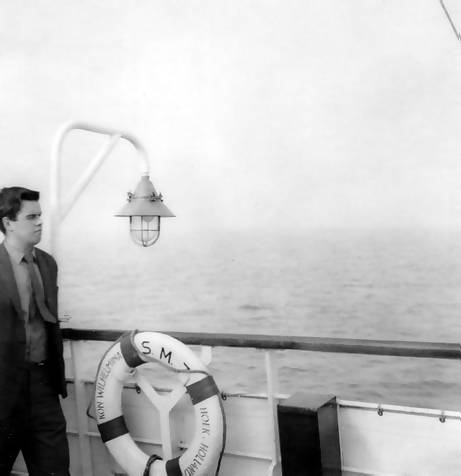
|
|
Carl Thomson on the ferry back to Harwich from Holland. Photo provided by Carl.
|
RC: It was a penny halfpenny?
CT: Old penny halfpenny.
RC: Was it Sellotaped or just balanced?
CT: I think they were Sellotaped on, just to keep it going.
RC: They used those all the time or ...?
CT: All the time, yeah. Just to stop it jumping. (laughs)
RC: What about relationships with the DJs? I suppose you had the best of both worlds - friendly with them, friendly with the crew as well.
CT: Yeah. It was a good team effort, you know. You got on with most of the DJs. Most of them were OK. I've always said that, long before they had all these TV programmes of putting people together in a house, we were living together
on there. People were in the Merchant Navy on board ships for years at a time. You had to get on with people. You just got on with it.
RC: It was Big Brother before Big Brother was invented.
CT: Yes. That's right.
NOTES
|
|
During the night of 19/20 January 1966, the Mi Amigo lost her anchor and was washed up on the beach. More details here. The ship was taken to Holland for repairs and, at
the same time, a new 50 kilowatt transmitter was installed.
|
|
|
While the mi Amigo was being repaired, Caroline South borrowed the mv Cheeta II. This ship had previously been used by Radio Syd off the Swedish coast. More details here.
|
|
|
The transmitter on Radio City was actually bought by Project Atlanta from a Texan radio station KCUL Fort Worth. It was a dispute over ownership of this transmitter that led to the
raid on Shivering Sands and the shooting of City's owner Reg Calvert.
|
|
|
Caroline South can not possibly have had 30 million listeners. A survey carried out by Attwood Statistics in 1964 estimated that 33.22 million people in total (over the age of 16) lived in an area
where they could hear one of the two Caroline ships. At that time it was reported that 12.624 million people had tuned in to one of them during the course of a week. That was before the arrival of Radio London. A survey
carried out by National Opinion Polls in 1966 showed that the Caroline network then had 8.818 million listeners. Radio London had 8.14 million.
|
|
|
Thanks to correspondent Hans Klomp for pointing out that this should be Redwise or Redwijs.
|
|
|
When the Mi Amigo returned from being repaired there was a delay before it could take over from the mv Cheeta II because of a fault with the aerial. The story of Tony Blackburn climbing the mast to
fix it is told here.
|
|
|
Originally both the Fredericia and Mi Amigo had two 10 kilowatt transmitters. While the Mi Amigo was in Zaandam one of the 10s was removed for use on the Cheeta II and the new 50 kilowatt was installed.
|
Back to Ray's chat with Peter Philips.
Ray's conversation with Colin Berry is over the page.
|

